PennDOT seeks public-private partnership to address major bridges
Through a public-private partnership, the Pennsylvania Department of Transportation replaced more than 550 small bridges across the state in just under three years.
Now, PennDOT hopes to do the same to address major bridges statewide.
“A lot of these bridges were designed in the ‘50s and built in the ‘60s, and they’re coming up on the end of their useful lives,” said Ken McClain, director for PennDOT’s Alternative Funding Program. “They were designed to accommodate traffic in the 1950s — trucks are larger today, vehicles travel faster today, so we’re making sure that we make road improvements to help with safety as well.”
McClain said PennDOT will target the replacement of bridges on interstates and expressways. Pennsylvania’s interstate highways carry 25% of the state’s total traffic volume, he said.
“It’s not an option for us to allow these bridges to get into a state of disrepair to the point that they’re weight-restricted or closed,” he said.
However, PennDOT already has a host of projects in its pipeline, and McClain said paying for them out of the state’s existing Motor License Fund would come at the expense of those other projects.
Private equity can be leveraged through public-private partnerships, and tolls can be implemented to raise money — thanks to Act 88 of 2012, he said.
“A lot of these bridges are very, very large, very, very costly and quite honestly, our existing funding streams can’t support (that scale of project),” McClain said.
That means PennDOT officials will seek to spread projects out across the state, “so there aren’t user fees assessed too harshly in any one area of the state,” he said.
There are plenty of candidates to spread out the work statewide, from the Birmingham and Fort Duquesne bridges in Pittsburgh to the bridges carrying Route 30 over Slate Creek in Hempfield and Loyalhanna Creek in Unity.
McClain said PennDOT officials will look statewide to determine what bridges meet their specifications.
“We’re looking at trying to attack between five and 10 bridges in the first phase,” he said. “Once they’re identified, we’ll have to go through the (National Environmental Policy Act) process, where we engage the community, solicit their feedback, inform them that the project will be funded through tolls, and look at the economic impact that will have on communities.”
The process will also examine what McClain called “divergences” — whether drivers are likely to change their routes to avoid a bridge toll, and what impact that could have on other area roads.
McClain said he hopes to identify bridges for the first phase in early 2021, followed by a 12- to 15-month process of contracting the work.
“It’s a really good time right now to leverage private equity, and we feel we can get competitive rates and implement this in a very cost-beneficial way,” McClain said.
Patrick Varine is a TribLive reporter covering Delmont, Export and Murrysville. He is a Western Pennsylvania native and joined the Trib in 2010 after working as a reporter and editor with the former Dover Post Co. in Delaware. He can be reached at pvarine@triblive.com.
Remove the ads from your TribLIVE reading experience but still support the journalists who create the content with TribLIVE Ad-Free.

